Are you tracking the right metrics for your influencer marketing campaigns? If you’re going to see how your efforts are paying off, it’s important to focus on key performance indicators (KPIs) that align with your goals.
According to our State of Influencer Marketing Benchmark Report, the most common metrics for measuring influencer marketing success are:
But these aren’t the only metrics you should look at. This guide explores some of the most important influencer marketing KPIs you need to track for success. Let’s get started.
Core Influencer Marketing KPIs You Need to Track
As most influencer marketing campaigns are carried out online via social media, their success is measured through a few key social media metrics. Additionally, there may be other digital marketing KPIs that can help you understand the impact of your campaigns. All of these influencer marketing KPIs can be divided into six core categories.
1. Reach and Awareness
Funnel Stage: Top of the funnel
With brand awareness being one of the main goals of influencer marketing, many brands track success by seeing how well their campaign is reaching people. Metrics related to reach and awareness can be used to measure the impact of your influencer partnerships.
- Impressions: Impressions is a measure of how often content is displayed to users. It gives you an idea of how effectively your campaign gets in front of people.
- Reach: This measure the number of unique viewers who saw the content. It’s an even more accurate measure of how effectively your campaign is reaching people, making it particularly useful for tracking brand awareness goals.
- Brand awareness surveys: Beyond the above quantitative metrics, make sure to incorporate qualitative methods to measure how campaigns influence perception. Conduct brand awareness surveys to see if your influencer marketing campaigns are impactful enough to change how people see your brand and how memorable your brand is.
When The Body Shop wanted to raise awareness of their brand activism in the Middle East, they ran an 18-month-long influencer campaign and tracked impressions and reach. In addition to achieving 30 million impressions and 17 million in reach, the brand also witnessed a 17% lift in sales.
2. Audience Growth
Funnel Stage: Top of the funnel
In the same vein, many brand’s want to grow their audience through influencer marketing. This requires looking at how influencers help them attract new followers. You’ll want to closely look at your follower count growth and compare the numbers against your growth before partnering with influencers.
However, with influencer fraud on the rise, it’s important to closely track the quality of followers gained through your campaign. You can use our fake follower checker and other audience quality scoring tools for this.
When ODEON partnered with The Goat Agency for an influencer marketing campaign, follower growth was one of the key metrics they measured. Their TikTok account grew from 4k followers to 100k followers through strategic influencer partnerships.
@hannahlowther Get your boots on and get to @odeoncinemas to watch Puss in Boots: The Last Wish ad #FeelsGoodToFeel ♬ Salsa en la Calle (Instrumental) – Sr Ortegon
3. Engagement Metrics
Funnel Stage: Middle of the funnel
These metrics help you understand how your audience is responding to the campaign. They’re particularly useful for measuring the impact of specific influencers and how their content resonates with the audience.
You may keep track of a variety of engagement metrics depending on the platform you use and the influencer marketing strategy. For instance, if the campaign is executed through Instagram Stories, you’ll want to measure for Stories engagement metrics such as likes and replies. In general, however, here are some of the key engagement metrics to track.
- Likes, comments, shares: These metrics help you track how people are interacting with the influencer’s content. A generous amount of likes and comments can show you if people enjoy the content enough to interact with it. Shares show you that people loved the content so much they wanted to share it with friends.
- Engagement rate: It’s also important to measure these interactions against the influencer’s follower count by calculating engagement rate. 500 interactions on a post by an influencer with 100,000 followers may not seem like much, but it could be significant for an influencer with 5,000 followers.
It tells you what portion of the influencer’s followers are actually engaging with the campaign content. So make sure to calculate engagement rate to see just how impactful your campaign is and whether the influencer is engaging their audience. - Sentiment analysis: The above metrics only paint half of the picture as they don’t necessarily tell you the sentiment behind those engagements. Even a controversial post could gain significant engagement without positively influencing people’s perceptions. So it’s important to conduct a sentiment analysis and understand if the influencer is boosting positive brand perception.
Sephora partnered with the following nano-influencer to promote the Sol de Janeiro holiday sets. Her Reel received over 9k likes and tons of positive comments although she has just 3.6k followers. These positive engagement metrics speak for the campaign’s success.
4. Traffic and Click-Through Rates
Funnel Stage: Middle of the funnel
People may see and engage with the influencer content, but are they interested enough to click on the link and visit your website? This is where you need to track other middle-of-the-funnel metrics like traffic and click-through rates.
- Website traffic: The referral traffic from influencers’ content can give you an idea of just how invested people are in learning more about your product. Make use of UTM codes to accurately attribute your website visits to the right influencers.
- Click-through rate (CTR): Similarly, you’ll want to track how many times people clicked on the campaign links promoted by an influencer. Whether it’s to a specific landing page or a product page, you can use unique referral links to help with your tracking.
When Kraken wanted to build awareness and excitement for their new Kraken Gold Spiced Rum, they monitored a combination of metrics, including clicks. The campaign generated almost 300k clicks to the Kraken website.
5. Conversions
Funnel Stage: Bottom of the funnel
For businesses whose main goal is to generate direct sales through influencer marketing, it’s crucial to monitor your conversion metrics. Depending on the type of product you sell, these conversion metrics may not necessarily be purchases but also things like downloads and signups. While most conversion metrics are bat the ottom of the funnel, metrics like lead generation are at the middle of the funnel.
- Conversion rate: This is the rate at which your influencer campaign drives actual purchases or desired actions. You’ll want to measure the number of people who took the desired action and compare that against the total number of people who saw your campaign.
- Affiliate sales and referral links: When it comes to campaigns where the goal is to generate sales, you’ll want to track purchases made using affiliate referral links and discount codes. This allows you to see which sales can be directly attributed to the influencer’s efforts.
- Lead generation: For B2B campaigns that deal with longer sales cycles, it’s important to track qualified leads and form submissions. This often requires robust measurement tools that integrate with your CRM and make use of UTM tracking to attribute your lead generation to specific influencer campaigns.
For companies like USIMS, which sell eSIMs, downloads and installations were some of the key metrics for campaign measurement. They were able to attribute over 300k downloads to influencer marketing.
6. ROI (Return on Investment)
Funnel Stage: Varies depending on campaign goal
Finally, some brands will also want to look at the overall returns generated from their influencer marketing campaign. This can be a bit tricky to measure, depending on the campaign goal. However, it’s usually calculated against the amount of money spent on influencer marketing.
Influencer marketing ROI is usually calculated based on other metrics like direct sales compared to how much you spent on the campaign. The formula to calculate it is:
ROI = (Revenue/Cost) x 100
So if you spent $5,000 on influencer marketing and generated sales worth $20,000, your ROI is:
ROI = (20,000/5,000) x 100 = 400%
Other metrics like earned media value and customer lifetime value (more on this later) can also help you measure your campaign ROI. Similarly, the metrics that are included in influencer marketing ROI calculation vary from campaign to campaign. Arm & Hammer, for instance, tracked impressions, clicks, and paid media engagement. They witnessed a return on ad spend (ROAS) of $1.71 along with a 24% paid media engagement rate.
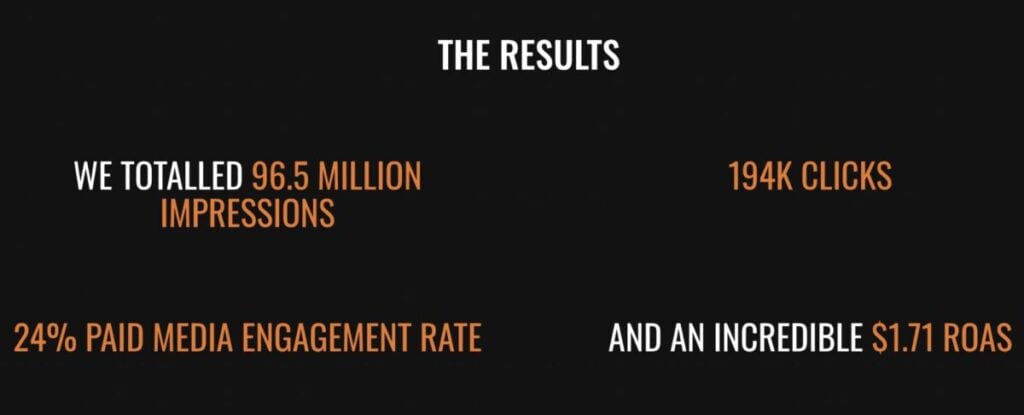
Advanced KPIs for Influencer Marketing: Beyond the Basics
Besides the above core influencer marketing KPIs, there are a few more advanced metrics to help you get deeper into your campaign measurement. These metrics help you understand the long-term value that influencers generate for your brand.
Long-Term Brand Loyalty and Sentiment
For many brands, it’s not just about driving immediate results through influencer marketing but also about generating long-term impact. As such, it’s crucial to measure long-term engagement with influencers to ensure that their investment is paying off in the long run.
This usually involves continuous monitoring and looking out for specific metrics that relate to brand loyalty and sentiment. You’ll want to make use of sentiment analysis tools to see how your brand sentiment is evolving before, during, and after the campaign. Make sure to keep going back to see if the positive sentiment continues long after the campaign has ended.
Additionally, you’ll want to see if influencers are helping drive brand loyalty. This typically involves seeing whether the customers acquired through influencer marketing are making repeat purchases. Customer retention rate is another important loyalty metric to use in your analysis.
Keep in mind, however, that the onus of driving long-term brand loyalty is also on you. The experience you deliver during and after the purchase can impact how customers feel about your brand and whether they come back for another purchase.
Influencer-Brand Alignment
For your influencer campaign to deliver the desired impact, it needs to resonate with your target audience. This makes it crucial to work with influencers whose values align with yours, which will allow you to authentically engage the type of audience you want to reach.
However, influencer-brand alignment is a bit tricky to measure as it involves a combination of various metrics. The first thing you can look at is the niche or industry that the influencer specializes in. Their engagement rate also gives you an idea of whether they’re able to actively engage people in the desired industry.
With the rise of influencer fraud, brands will also want to ensure that the following and engagements an influencer is receiving are authentic. This makes it crucial to look into their audience quality score on platforms like Upfluence. The platform can show you the percentage of influencers’ real followers. It can even help you discover influencers who already love your brand for an even more authentic partnership.
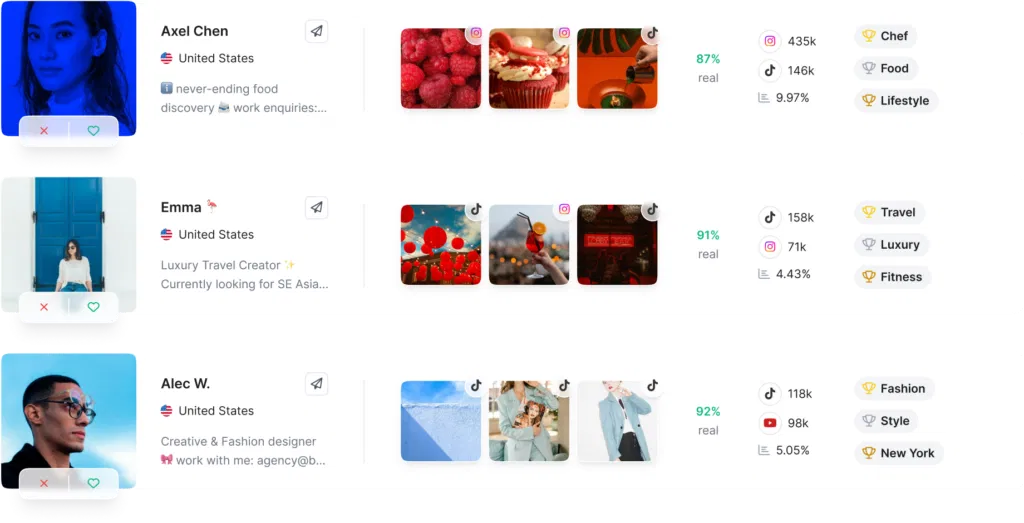
Additionally, Tagger by Sprout Social can also conduct a brand affinity analysis to help you easily find influencers who are closely aligned with your brand. The Content Health feature further helps with your analysis by automatically evaluating the quality of their content based on various performance metrics.
Earned Media Value (EMV)
Earned media value, or EMV in influencer marketing, is a measure of the value of publicity generated by influencers, not including paid advertising. The EMV calculation process varies depending on the type of campaign and campaign goal. However, the most common method is by multiplying impressions with cost per impression.
Some may also include other variables like engagements or click-throughs in the calculation. For example, Tezos partnered with nine creators to raise awareness about their open-source blockchain network. They used content views to calculate their earned media value. With over 1 million views garnered, the campaign generated $167k in influencer media value.
Customer Lifetime Value (CLV)
The customer lifetime value (CLV) is a metric for measuring the long-term value generated by your influencer marketing campaigns. It shows you how much revenue you can expect to earn from a customer during their lifetime with your brand. So it’s an important metric to understand customer loyalty and retention.
You can calculate your CLV using the following formula:
CLV = Customer Value x Average Customer Lifespan
To calculate CLV for influencer marketing, you’ll need to create a segment of customers that came from influencer referrals. Then track the purchases they make and time spent with your company. Multiply their purchase frequency by the average value of purchases to get your customer value. Then use the formula above to calculate influencer marketing CLV.
Measuring Influencer Impact on Video and Live Content
With video marketing being the hottest trend today, many influencer marketing campaigns also leverage video. These types of campaigns require a unique set of metrics to accurately measure performance.
KPIs for Video-Based Platforms (YouTube, TikTok, etc.)
Video influencer marketing is mostly carried out through YouTube, TikTok, and Instagram Reels. Depending on which platform you use, the following KPIs can help you understand your campaign performance:
- Views – Views is a measure of the number of times the content is actually viewed. This helps you understand how effectively your campaign’s video content is reaching people.
- Watch time – This is the average time spent watching the video, including replays and rewatches. You’ll ideally want longer watch times as they indicate that people are invested enough in the content.
- Comments – Comments are an engagement metric, which shows that people are interacting with the video.
- Shares – Shares also indicate that people enjoy the video enough to share it with friends. It’s a good measure of content quality and could even determine virality.
- Video completion rate – This is a measure of the percentage of viewers who watched the entire video until the end. It’s an excellent indicator of how engaging the video is, helping you understand the influencer’s ability to keep their viewers tuned throughout the duration of the video.
When Euroleague Basketball wanted to start their own TikTok channel, they were experiencing low engagement and slow follower growth. So they engaged key personalities to create an engaging channel and grow their community. They focused on metrics like video views, engagements, and engagement rate to measure performance and gained 238k followers at a month-on-month growth rate of 10%.
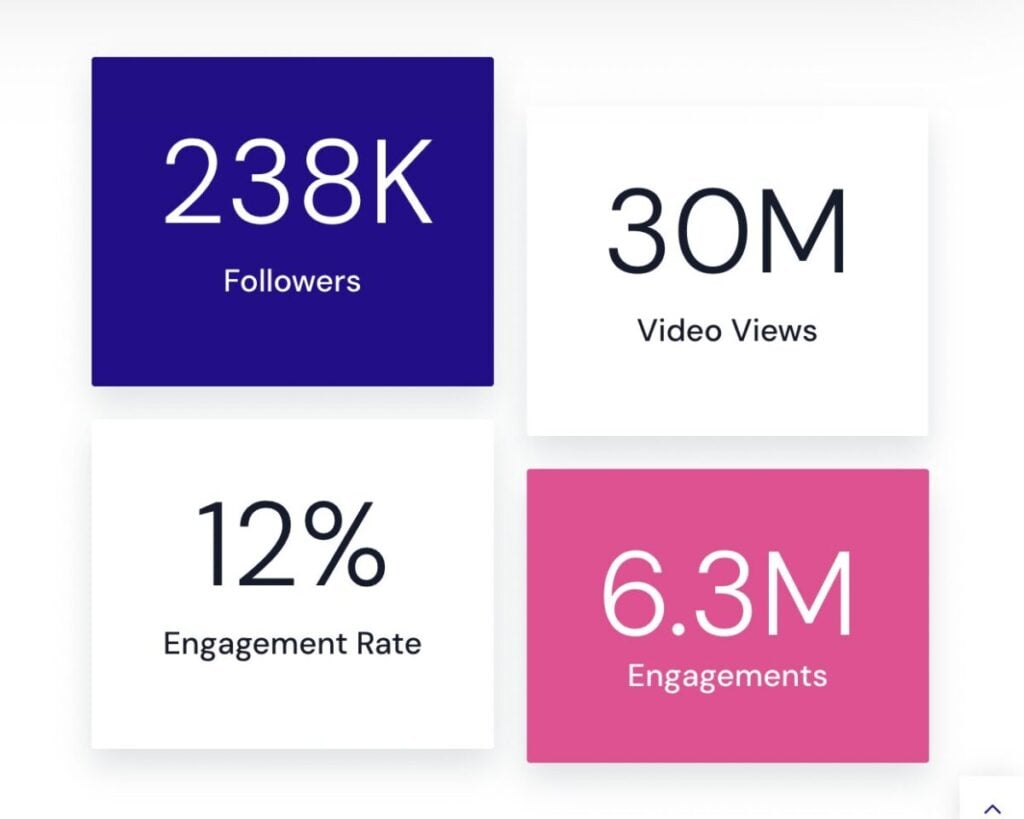
Live Stream Metrics
For influencer campaigns that involve live streaming, it’s all about real-time engagement metrics to measure performance. The actual metrics may vary depending on the live stream platform you use, but will typically involve the following:
- Viewership – This refers to the number of people who tuned into the livestream session. It helps you understand how effectively your live stream is reaching people.
- Interactions – These are engagement metrics to measure the number of times people interacted with the live stream, typically by commenting or engaging in the chat window.
- Conversions – If your live stream sessions are intended to drive sales or other types of actions, you’ll want to look at conversion metrics. On platforms like TikTok LIVE, viewers will even have the option to buy stuff featured in the live stream. So you can easily track the sales generated during the session.
Wayfair engaged leading social media personalities to host their live shopping sessions on TikTok and Instagram. They kept track of metrics like live stream views and live stream engagements to track the performance of the campaign. The campaign saw over 185k livestream views and over 76k livestream engagements.

B2B Influencer Marketing KPIs
While influencer marketing was once considered exclusive to the B2C space, it has since been embraced even in B2B marketing. However, with longer sales cycles and platform variations, the metrics used for measuring success are slightly different from traditional influencer marketing.
Unique KPIs for B2B Campaigns
There are several KPIs unique to B2B influencer marketing due to factors like the types of products being sold and the platforms used. Since B2B products are typically of higher value and involve several stakeholders, direct sales isn’t usually the top influencer marketing KPI. Instead, the focus is on subscriptions, signups, and leads, depending on the product.
Additionally, brand awareness goals may require measurement through industry mentions. B2B brands work with influencers to gain recognition and build credibility. So, an increase in industry mentions indicates that your campaigns are helping you build an industry presence.
When Adobe activated leading B2B influencers to boost awareness and generate leads, they developed valuable influencer-led content and promoted it through various channels. This included organic and paid LinkedIn posts, email, and influencer amplification with the goal of encouraging downloads by submitting a form.
They then tracked the performance through content engagement and form completion rates. While the influencer-led content saw 2x more engagement than comparable Adobe campaigns, form completion rates on LinkedIn also increased by 150%.

Tracking B2B Metrics
The process of tracking your B2B influencer marketing metrics will vary depending on the campaign type and the platform you use. Most of the time, however, you can use the native analytics dashboard of your chosen social media platform to measure the impact of both organic and paid campaigns.
LinkedIn Analytics, for instance, can give you content-specific metrics and account performance reports to track how your campaigns are performing. You can combine additional insights from your Google Analytics to gain a complete picture of your campaign impact.
Invoice Fly leveraged TikTok to promote their invoicing tool and targeted freelancers, small businesses, and contractors. They engaged professionals across a variety of industries to show how the app simplified invoicing tasks and amplified the content through paid ads. They were able to accurately track metrics like installs and cost, with the campaign generating 2,000 paying monthly subscribers at a cost per install of $3.5.
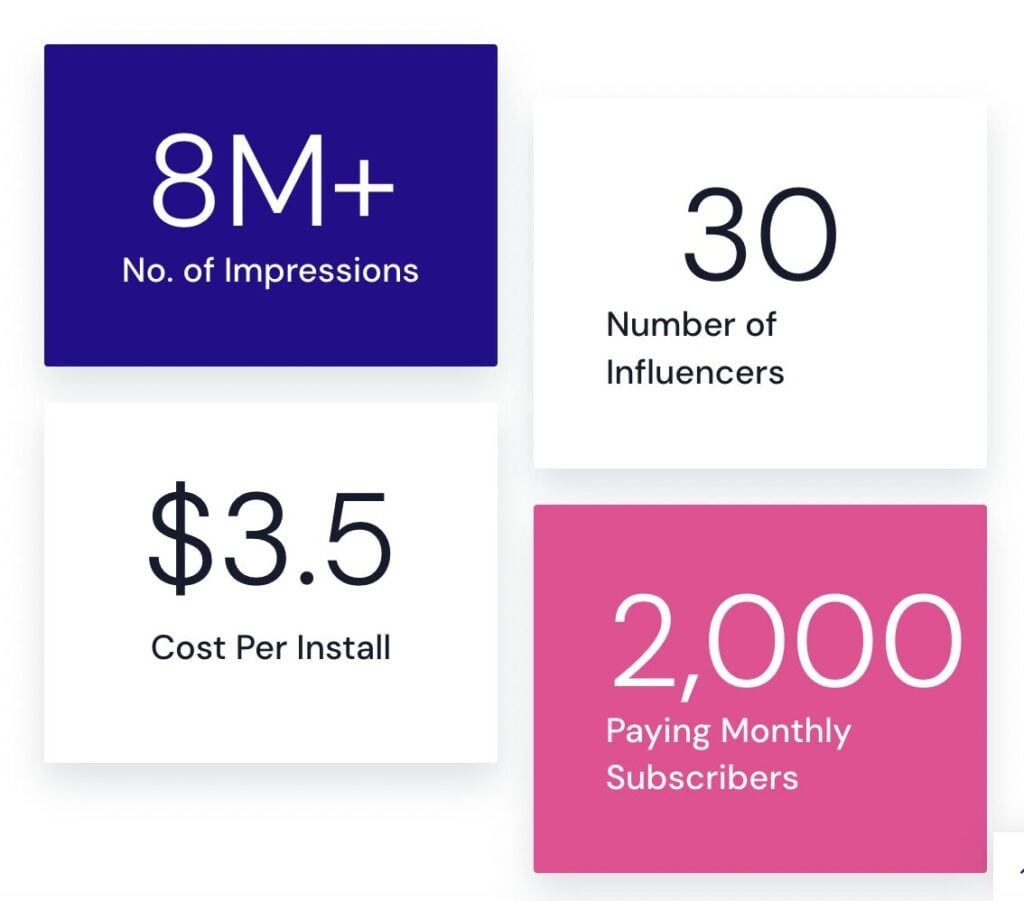
Tools to Track Influencer Marketing KPIs
Tracking influencer marketing KPIs may require a combination of tools depending on the metrics you want to track and influencer marketing tactics. If your main focus is on vanity metrics like impressions and reach, you can find all this within your native social media analytics. Engagement metrics are also easy to track within social media platforms.
However, if you’re going deeper to see other engagement and conversion metrics such as traffic, clicks, and conversions, you’ll need to make use of UTM codes and Google Analytics. This involves attaching unique UTM parameters to the links shared by influencers, and then tracking traffic, clicks, and conversions coming from these links from your GA dashboard.
Many influencer analytics tools also come with built-in tracking capabilities to streamline campaign measurement. They let you see all the important KPIs in one place and even let you track metrics like sales and conversions. Some even come with features to easily generate unique discount codes and referral links that you can then track within the platform.
Brandwatch Influencer Marketing, Modash, and Upfluence are some of the best tools for tracking influencer marketing KPIs.
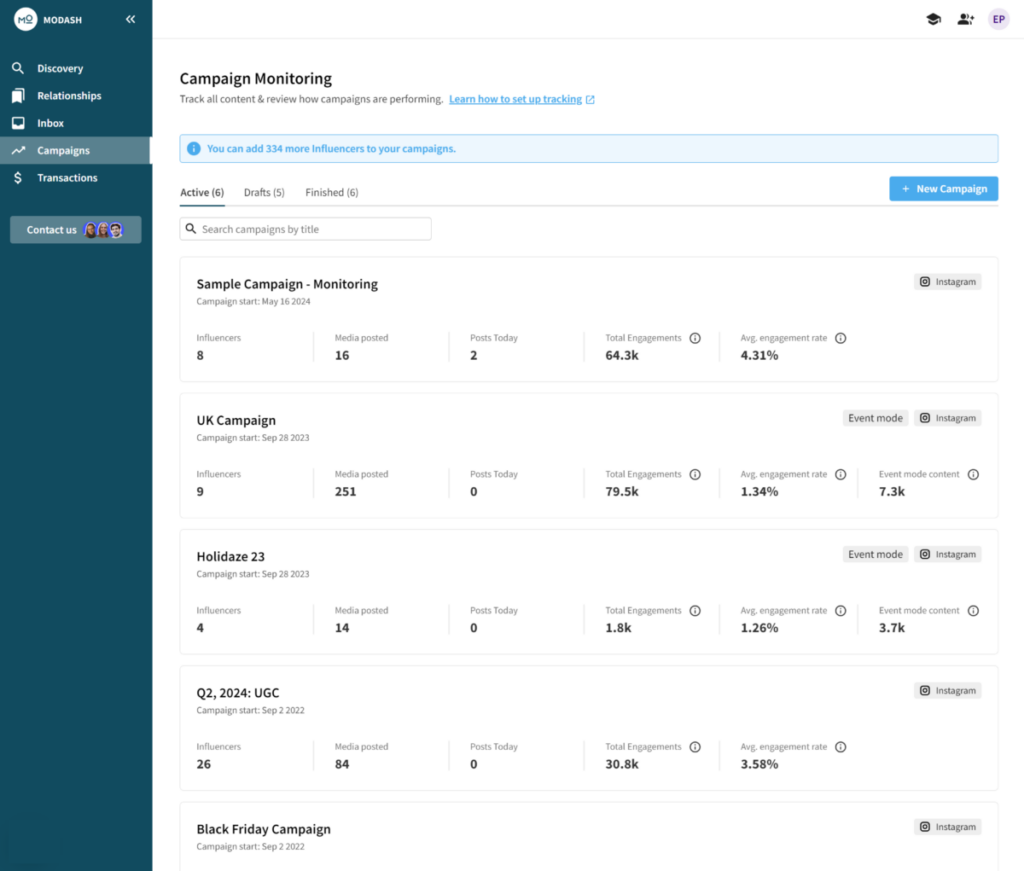
Challenges in Measuring Influencer Marketing KPIs
Even with the best tools and the right methods of measuring influencer marketing KPIs, some brands still experience a few challenges. Being aware of these challenges will help you understand how to best address them.
1. Attribution Issues
Brands may face challenges attributing results to the right campaign and influencers. This is particularly true for campaigns that involve multiple influencers and for brands running several campaigns simultaneously.
This is where UTM codes and unique referral links or discount codes come in, making it easier to attribute results to specific sources. Additionally, multi-touch attribution models will also help with accurate campaign measurement.
2. Multi-Channel Marketing Challenges
For campaigns that involve influencer activations across multiple channels, it may be difficult to understand which metrics to track and which channels are driving results. The best thing to do is to decide early on which metrics to focus on depending on your campaign goal. You can then narrow down the most relevant metrics across each platform to simplify campaign measurement.
3. Fake Followers and Engagement
Influence can be faked…to a certain extent. So if you’re only measuring results by impressions, audience size, and engagement, your metrics may be flawed.
It’s important to use influencer vetting tools to analyze their audience quality and ensure that you’re reaching real people through your campaigns. This increases the likelihood that the engagements generated by the campaign are also authentic.
Measure and Optimize Your Influencer Marketing Campaigns
Influencer marketing campaigns don’t always succeed the first time around. Even if they do, there’s always an opportunity to improve your results, whether it involves lower spending or greater reach. This makes it crucial to keep a close eye on relevant KPIs so you can continue to optimize your influencer marketing campaigns.
Frequently Asked Questions
What are the key performance indicators (KPIs) for measuring the success of an influencer marketing campaign?
Reach, impressions, views, engagement, and sales are some of the KPIs for measuring influencer marketing success.
How can engagement rate be tracked in influencer marketing?
You can track engagement rate in influencer marketing by dividing the total number of interactions by the total number of followers. Influencer analytics tools can simplify the calculation process.
What is the role of reach and impressions in influencer campaigns?
Reach and impressions are a great way to measure brand awareness goals in an influencer marketing campaign. They help you understand how effectively your campaign’s content is reaching people.
How do I track conversions from influencer marketing campaigns?
You can track conversions from your influencer marketing campaigns by using unique referral links and discount codes and tracking the purchases made.
How important is follower growth in evaluating an influencer campaign’s success?
Follower growth is an important metric for measuring how effectively you’re growing your audience as a result of your influencer marketing campaign. It tells you how many people not only saw and engaged with the influencer’s content but felt compelled to follow your brand.
What metrics should be used to measure content quality and relevance?
Engagement rate and sentiment are some of the most important metrics for measuring the quality and relevance of an influencer’s content.
What is the significance of customer acquisition cost (CAC) in influencer campaigns?
Customer acquisition cost (CAC) is an important metric to understand the ROI of your influencer campaign as it helps you compare your results against your expenses.
